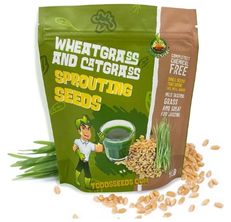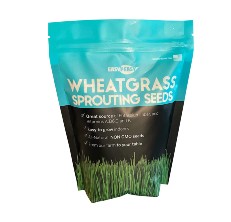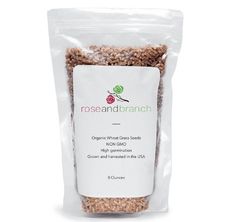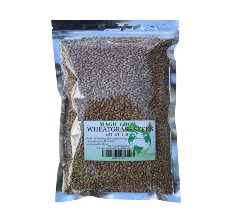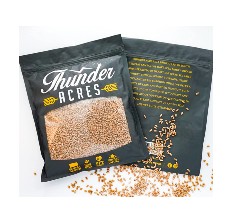Exhaustion is a normal experience that just about everyone faces from time to time. But what about situations where the tiredness never goes away? For instance, do you feel drained while carrying out your daily chores? Or have you been unable to focus at work?
The solution to this problem might be as simple as you lacking certain nutrients that your body needs to perform everyday tasks properly. Wheatgrass seeds could be the missing piece, and if you want to try them as a way of completing your diet, we recommend starting with Todd's Seeds Wheatgrass Seeds.
Our Top Picks For Wheatgrass Seeds
Buying Guide: The Best Wheatgrass Seeds
Purchasing the perfect wheatgrass seeds can be daunting since you must consider various factors. That’s why, to help you navigate the market, we prepared a comprehensive buying guide to explain everything you need to know about wheatgrass seeds and how to find the right ones.
Factors To Consider When Buying Wheatgrass Seeds
If you want to purchase wheatgrass seeds, here are some features you should look out for:
Packaging and survivability
Wheatgrass seeds are sensitive to the outside environment, so most high-quality seeds must be stored in airtight bags to keep them fresh. We recommend purchasing seeds that are kept in resealable bags since their quality will be preserved for a more extended period. It will also make it easier for you since you won’t have to worry about getting an airtight container.
Germination rate
Germination rate is important to keep in mind before purchasing wheatgrass seeds. Many low-quality seeds don’t germinate, risking that your hard-earned money will go to waste. To avoid this unfortunate scenario, we recommend buying wheatgrass seeds from brands that are well-known or advertise a 100% germination rate.
Non-GMO
You’ll often see a non-GMO certification alongside many wheatgrass seeds on the market. If you’re unfamiliar with this term, non-GMO means the seeds are not genetically modified. That is why we recommend buying wheatgrass seeds that are non-GMO certified, as they can be safer and more nutritious to consume.
Quantity of seeds
Many wheatgrass seeds come in large quantities. If you’re new to growing these seeds, there’s a high probability you may face some failures. We recommend you get a large number of seeds since it will allow you room for failure.
Lighting sources
We recommend getting wheatgrass seeds that require little sunlight since they are easy to grow indoors. Some seeds can also be grown fully with artificial sunlight, so you don’t need to worry if the area you live in mostly has cloudy weather. For seeds that require less light, you can put them in a tray facing the window since that will help them get the sunlight they need to grow into nutritious wheatgrass.
USDA organic
Products marked USDA organic are tested repeatedly for safety. This means they have passed through rigorous conditions and are guaranteed to be natural, organic, and better than other wheatgrass seeds.
That is why it’s always a good idea to buy wheatgrass seeds with this certification, as it ensures that the seeds will pose no threats to your health while providing you with your daily dose of nutrients.
Tips To Grow Wheatgrass Seeds
Below, we cover some helpful tips to help you grow wheatgrass with ease:
Overwatering
Be cautious not to overwater your seeds to keep them from rotting. The soil should be kept moist and not too soggy. If you’re using a pot to water your plants other than a sprinkler, be careful not to overwater the soil.
Fertilizing
Since wheatgrass seeds already germinate and mature in a brief period, it is advisable not to use any sort of fertilizers since it will just ruin the whole batch of wheatgrass and cause wilting.
Look for mold
If you see mold growing near your wheatgrass seeds, we advise you to discard all the seeds and remove the mold before starting over again. The best way to prevent contamination is to sanitize with a 10% bleach solution.
Sprouting
Place your seeds in mild water to let them sprout. If they haven’t sprouted in a week, it is recommended to discard the seeds and plant them again since this usually means something is wrong.
Container
If you’re looking to grow wheatgrass seeds at home, using a shallow pot or something with an effective water-draining system is ideal. You can also opt for specialized microgreen trays for growing sprouts that not only allow water to pass through but also provide more room for the sprouts to grow. If you’re looking to purchase a plastic container, then get one that is made of BPA-free plastic since it’s less harmful and won’t contaminate your seeds.
How To Use Wheatgrass in Cooking
Here are some ways you can make the most out of the wheatgrass grown from your seeds:
Drinks
You can blend wheatgrass into your drinks to cool you down after a hot day outside and give you all the necessary energy to recharge. If you don’t like the green color of it, we recommend adding just a teaspoon of wheatgrass since this way, it won’t change the color of your drink, but you’ll still get beneficial nutrients from it.
Sauces
You can reap the advantages of wheatgrass by adding it mildly into sauces like ranch or to the end of your pasta to maximize its nutritional value. Note that wheatgrass will provide the most value if it’s uncooked.
Breakfast
You can kickstart your day with a healthy and nutritious meal by adding wheatgrass to your yogurt or maybe even your morning smoothie. It is a genius and easy way to start the day and will make you feel more active throughout it.
People Also Asked
How long does it take to grow wheatgrass?
Wheatgrass seeds usually don't take much time to grow. In most cases, they take anywhere from six to ten days.
Can I eat raw wheatgrass seeds?
Yes, you can eat raw wheatgrass seeds. However, it is advised that you soak the seeds for about two to three days before consuming them. This will kill any bacteria in the seeds, making it safer for you to consume them.
Does wheatgrass keep growing?
Wheatgrass can regrow after you initially harvest it, but the second batch will have considerably fewer nutrients. The second batch might be of lower quality as well.
Is wheatgrass safe for my pets?
Organic wheatgrass is safe for your pets. However, if they eat large quantities, they might end up upsetting their stomachs.
Do wheatgrass seeds pose any side effects?
Although wheatgrass seeds are healthy to consume, they can cause side effects, like nausea or constipation. You might also want to avoid eating wheatgrass if you're pregnant or breastfeeding since there is not enough research to prove that wheatgrass is safe for pregnant or lactating people.




